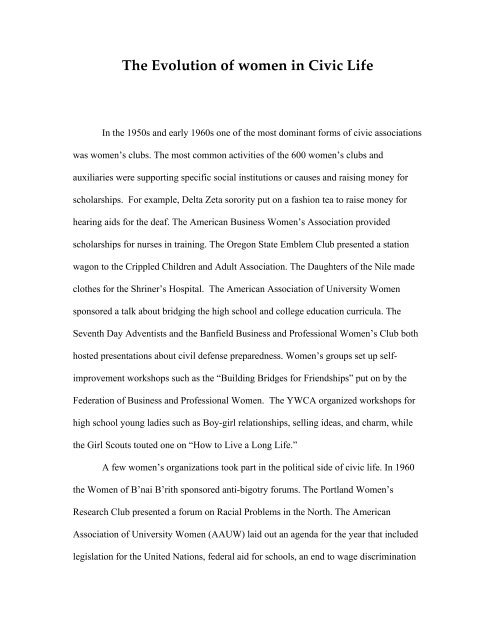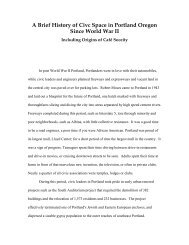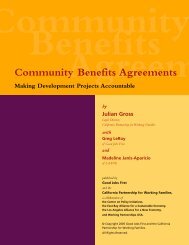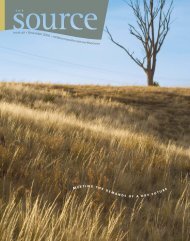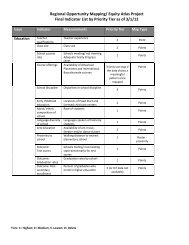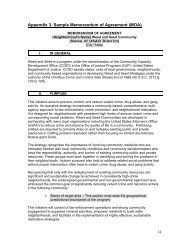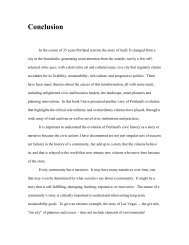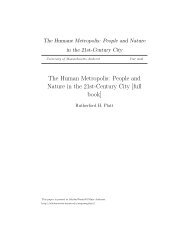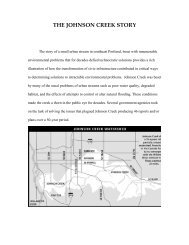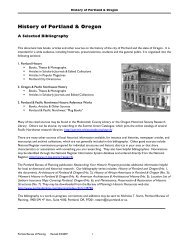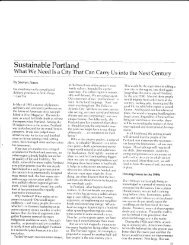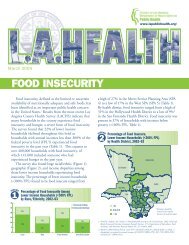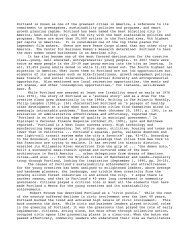The Evolution of women in Civic Life - Steven Reed Johnson
The Evolution of women in Civic Life - Steven Reed Johnson
The Evolution of women in Civic Life - Steven Reed Johnson
- No tags were found...
You also want an ePaper? Increase the reach of your titles
YUMPU automatically turns print PDFs into web optimized ePapers that Google loves.
<strong>The</strong> <strong>Evolution</strong> <strong>of</strong> <strong>women</strong> <strong>in</strong> <strong>Civic</strong> <strong>Life</strong><br />
In the 1950s and early 1960s one <strong>of</strong> the most dom<strong>in</strong>ant forms <strong>of</strong> civic associations<br />
was <strong>women</strong>’s clubs. <strong>The</strong> most common activities <strong>of</strong> the 600 <strong>women</strong>’s clubs and<br />
auxiliaries were support<strong>in</strong>g specific social <strong>in</strong>stitutions or causes and rais<strong>in</strong>g money for<br />
scholarships. For example, Delta Zeta sorority put on a fashion tea to raise money for<br />
hear<strong>in</strong>g aids for the deaf. <strong>The</strong> American Bus<strong>in</strong>ess Women’s Association provided<br />
scholarships for nurses <strong>in</strong> tra<strong>in</strong><strong>in</strong>g. <strong>The</strong> Oregon State Emblem Club presented a station<br />
wagon to the Crippled Children and Adult Association. <strong>The</strong> Daughters <strong>of</strong> the Nile made<br />
clothes for the Shr<strong>in</strong>er’s Hospital. <strong>The</strong> American Association <strong>of</strong> University Women<br />
sponsored a talk about bridg<strong>in</strong>g the high school and college education curricula. <strong>The</strong><br />
Seventh Day Adventists and the Banfield Bus<strong>in</strong>ess and Pr<strong>of</strong>essional Women’s Club both<br />
hosted presentations about civil defense preparedness. Women’s groups set up selfimprovement<br />
workshops such as the “Build<strong>in</strong>g Bridges for Friendships” put on by the<br />
Federation <strong>of</strong> Bus<strong>in</strong>ess and Pr<strong>of</strong>essional Women. <strong>The</strong> YWCA organized workshops for<br />
high school young ladies such as Boy-girl relationships, sell<strong>in</strong>g ideas, and charm, while<br />
the Girl Scouts touted one on “How to Live a Long <strong>Life</strong>.”<br />
A few <strong>women</strong>’s organizations took part <strong>in</strong> the political side <strong>of</strong> civic life. In 1960<br />
the Women <strong>of</strong> B’nai B’rith sponsored anti-bigotry forums. <strong>The</strong> Portland Women’s<br />
Research Club presented a forum on Racial Problems <strong>in</strong> the North. <strong>The</strong> American<br />
Association <strong>of</strong> University Women (AAUW) laid out an agenda for the year that <strong>in</strong>cluded<br />
legislation for the United Nations, federal aid for schools, an end to wage discrim<strong>in</strong>ation
ecause <strong>of</strong> sex, and liberaliz<strong>in</strong>g <strong>in</strong>ternational trade agreements. <strong>The</strong> AAUW also pushed<br />
the state to enact stronger billboard restrictions on highways. <strong>The</strong> Portland Women’s<br />
Club focused on patient welfare. <strong>The</strong> Oregon Nurses Association lobbied the State <strong>of</strong><br />
Oregon for better health programs <strong>in</strong> schools.<br />
It is also evident from membership rosters <strong>of</strong> citizen advisory committees,<br />
commissions, and trade and pr<strong>of</strong>essional licens<strong>in</strong>g boards dur<strong>in</strong>g this period that <strong>women</strong><br />
were poorly represented. Of the 711 members <strong>of</strong> all the civic bodies, 591 were men (71<br />
percent). Women made up only 8 percent <strong>of</strong> the boards, 10 percent <strong>of</strong> the citizen advisory<br />
committees, and 26 percent <strong>of</strong> the commissions. While this last figure may seem high for<br />
the times, it should be noted that <strong>women</strong> served on commissions that were considered<br />
<strong>women</strong>’s doma<strong>in</strong>: arts and culture and human services. Of the 90 <strong>women</strong> on commissions<br />
dur<strong>in</strong>g this period, 58 served on the Arts Commission, Metropolitan Youth Commission,<br />
Zoo Commission, Pittock Mansion Commission, and Japanese Garden Commission. On<br />
the more powerful City Plann<strong>in</strong>g Commission, Portland Development Commission, and<br />
Hous<strong>in</strong>g Commission there were 10 <strong>women</strong> and 43 men.<br />
In the late 1960s and early 1970s many new <strong>women</strong>’s groups emerged, although<br />
traditional <strong>women</strong>’s organizations held their own <strong>in</strong> terms <strong>of</strong> number and membership.<br />
For example, the League <strong>of</strong> Women Voters’ membership decl<strong>in</strong>ed only slightly from 700<br />
<strong>in</strong> 1962 to 600 <strong>in</strong> 1972. <strong>The</strong> American Association <strong>of</strong> University Women’s membership<br />
<strong>in</strong>creased slightly between 1962 and 1972, from 653 to 700. Likewise the National<br />
Council <strong>of</strong> Jewish Women went up from 600 members <strong>in</strong> 1962 to 725 <strong>in</strong> 1972. Of<br />
course, the population <strong>in</strong> Portland had also <strong>in</strong>creased, which helps account for their<br />
numbers.
But, the figures demonstrate that while some <strong>women</strong> marched <strong>in</strong>to the halls <strong>of</strong><br />
power, most cont<strong>in</strong>ued to carry out their traditional roles through traditional civic<br />
organizations. A special <strong>in</strong>sert on <strong>women</strong>’s clubs <strong>in</strong> the Oregon Journal, (Solute to<br />
Women, 1969) summarized the contribution <strong>of</strong> <strong>women</strong> as “typified by club <strong>women</strong> <strong>in</strong> a<br />
number <strong>of</strong> ways. Usually they raise funds from bake sales, rummage sales or book sales<br />
with proceeds earmarked for hospitals, schools, nurs<strong>in</strong>g homes, or any <strong>of</strong> a thousand<br />
other places where there’s a need.” <strong>The</strong> editors also noted that, “along with self<br />
improvement the pr<strong>of</strong>essionally oriented <strong>women</strong> is concerned about her community.<br />
Climb<strong>in</strong>g the bus<strong>in</strong>ess ladder is vertical, but alert and aware <strong>women</strong> are constantly<br />
challenged to reach out horizontally to help others.”<br />
<strong>The</strong> doma<strong>in</strong>s <strong>of</strong> traditional <strong>women</strong>’s organizations and emergent fem<strong>in</strong>ist<br />
organizations were separate for the most part, but not always. In August 1972 a<br />
gather<strong>in</strong>g <strong>of</strong> <strong>women</strong>’s organizations called the Fem<strong>in</strong>ist Fare was representative <strong>of</strong> the<br />
cross-over between traditional <strong>women</strong>’s groups and new ones. <strong>The</strong> Fare, which created<br />
tables for <strong>in</strong>formation distribution, enterta<strong>in</strong>ment, and workshops and plays, <strong>in</strong>cluded<br />
traditional and new <strong>women</strong>’s organizations, <strong>in</strong>clud<strong>in</strong>g the Abortion Information and<br />
Referral Service, the International League for Peace and Freedom, Council <strong>of</strong> Jewish<br />
Women, Oregon Council for Women’s Equality, the National Council <strong>of</strong> Negro Women,<br />
the League <strong>of</strong> Women Voters, and YWCA.<br />
In this period, <strong>in</strong>deed, <strong>women</strong> woke up, <strong>of</strong>ten one by one, to the <strong>in</strong>equalities <strong>of</strong><br />
their status <strong>in</strong> society and to the power <strong>of</strong> <strong>women</strong> work<strong>in</strong>g together. <strong>The</strong>y gathered<br />
together <strong>in</strong> collectives, consciousness rais<strong>in</strong>g groups, and kitchens. Sally Landauer<br />
recalled how <strong>in</strong> 1967 she and Vera Katz, (two-term mayor <strong>of</strong> Portland <strong>in</strong> the 1990s) had
their “a-ha!” moment while on their knees, wax<strong>in</strong>g Vera’s kitchen floor, and wonder<strong>in</strong>g,<br />
“why are we do<strong>in</strong>g this (Bonner, 1994)” Betty Murten, a founder <strong>of</strong> Sensible<br />
Transportation Options for People (STOP), among other social causes, also remembered<br />
one <strong>of</strong> those moments:<br />
It was a time <strong>of</strong> beg<strong>in</strong>n<strong>in</strong>g to th<strong>in</strong>k globally and act locally. A lot was<br />
cook<strong>in</strong>g <strong>in</strong> those kitchens. What's <strong>in</strong>terest<strong>in</strong>g to me sociologically now is<br />
that we were probably the last generation <strong>of</strong> married <strong>women</strong> who had the<br />
luxury <strong>of</strong> be<strong>in</strong>g supported by our husbands, and we were all educated, so<br />
here was this <strong>in</strong>credible resource that the country doesn't have any longer.<br />
Families need two <strong>in</strong>comes, and so we don't have this <strong>in</strong>credible reservoir <strong>of</strong><br />
volunteer energy and <strong>in</strong>telligence today (Bonner, 2001a).<br />
Women banded together <strong>in</strong> political organizations and through political causes<br />
that sometimes took them across class boundaries. Women’s bookstores, health cl<strong>in</strong>ics,<br />
and hangouts such as the Mounta<strong>in</strong> Mov<strong>in</strong>g Café, became important places for <strong>women</strong> to<br />
meet as <strong>women</strong>. Bonnie T<strong>in</strong>ker, a founder <strong>of</strong> the Bradley Angle House, one <strong>of</strong> the first<br />
shelters for battered <strong>women</strong> <strong>in</strong> the country, recalled how her own awaken<strong>in</strong>g to political<br />
consciousness through the peace and non violence movement, was expanded by contact<br />
with <strong>women</strong> who had been abused <strong>in</strong> their marriages or families, so that she was made<br />
aware “that oppression was not just a theoretical construct, but that there were real<br />
material consequences to liv<strong>in</strong>g without money or education and suffer<strong>in</strong>g from violence<br />
(De Mar, 2003, p. 236)." S<strong>in</strong>ce the fem<strong>in</strong>ist awaken<strong>in</strong>g happened for some on many<br />
levels at once, from the macro or global to the micro or personalist political, <strong>women</strong> like<br />
T<strong>in</strong>ker found themselves rais<strong>in</strong>g their own consciousness, while try<strong>in</strong>g to push others and
society <strong>in</strong> a fem<strong>in</strong>ist direction--an excit<strong>in</strong>g but difficult surge <strong>of</strong> activities to susta<strong>in</strong>.<br />
<strong>The</strong>re were also many more new <strong>women</strong>-oriented or <strong>women</strong>-only organizations<br />
with a political orientation than there were <strong>in</strong> traditional civic Portland. In the early<br />
1970s Portland had a chapter <strong>of</strong> the National Organization for Women, as well as the<br />
Portland Area Women’s Political Caucus, a statewide political action group that worked<br />
to promote <strong>women</strong>’s issues and fem<strong>in</strong>ist candidates. Other <strong>women</strong>’s political<br />
organizations <strong>in</strong>cluded: the Progressive Women’s Association, the Council for Women’s<br />
Equality, and the Women’s Legislative Council. At least one traditional civic<br />
organization, the YWCA, turned with the tide <strong>of</strong> the <strong>women</strong>’s movement by open<strong>in</strong>g the<br />
Women’s Resource Center that provided direct services for <strong>women</strong>. <strong>The</strong> state <strong>of</strong> Oregon<br />
created the Governor’s Committee on the Status <strong>of</strong> Women and a separate advisory<br />
committee on the problems <strong>of</strong> <strong>in</strong>equalities <strong>in</strong> employment, the State Advisory Council on<br />
Sex Discrim<strong>in</strong>ation.<br />
Women were also storm<strong>in</strong>g the bastions <strong>of</strong> male power. <strong>The</strong> Portland City Club<br />
was beseeched by members <strong>of</strong> the Women’s Political Caucus and others to change its<br />
male-only membership rule. While many City Club members resisted, some such as<br />
prom<strong>in</strong>ent lawyer Sidney Lezak, supported the <strong>women</strong>, and resigned <strong>in</strong> protest. Sally<br />
Landauer (Bonner, 1994), one <strong>of</strong> the organizers who had confronted the City Club’s men<br />
recalled years later the action as both earnestly important and fun:<br />
So the Wednesday W<strong>in</strong>os became POW (Politically Oriented Women) or, as<br />
some <strong>of</strong> the men <strong>in</strong> the City Club called it, Penis Oriented Women. We picketed<br />
the City Club for at least two years. Every Friday we marched around the front <strong>of</strong><br />
the Benson Hotel (the hotel did not appreciate it!). That was where the City Club
met even then. We carried our signs. We marched.<br />
F<strong>in</strong>ally <strong>in</strong> 1974, and after several rejections, the City Club voted to allow <strong>women</strong><br />
full membership status. In 1982, Paul<strong>in</strong>e Anderson was elected as the Club’s first woman<br />
president. With an ironic sense <strong>of</strong> enfranchisement, also <strong>in</strong> 1974, the League <strong>of</strong> Women<br />
Voters passed a motion to allow men to jo<strong>in</strong>.<br />
It took years for other exclusively male clubs to follow the City Club’s lead.<br />
Some groups were forced to change. In 1987 the National Rotary Club was forced by the<br />
U.S. Supreme court to admit <strong>women</strong>. In 1989, the Royal Rosarians, Portland’s “goodwill<br />
ambassadors,” associated with the 100-year-old Rose Festival accepted <strong>women</strong> after the<br />
Portland City Council passed a resolution that forced them to change. <strong>The</strong> University<br />
Club and the Arl<strong>in</strong>gton Club, the traditional meet<strong>in</strong>g place <strong>of</strong> the civic elite, granted<br />
<strong>women</strong> full membership rights <strong>in</strong> 1990.<br />
Women-only health services, such as the Women’s Health Cl<strong>in</strong>ic, unheard <strong>of</strong> <strong>in</strong><br />
Portland <strong>in</strong> the early 1960s, were founded dur<strong>in</strong>g this period, and abortion was heat<strong>in</strong>g up<br />
as an issue, with both sides found<strong>in</strong>g political action organizations. In 1972, the antiabortion<br />
groups Oregon Right to <strong>Life</strong>, and Oregon Birthright, were formed. <strong>The</strong><br />
Women’s Health Cl<strong>in</strong>ic and the Abortion Information and Referral Service provided<br />
referrals for <strong>women</strong> want<strong>in</strong>g abortions. As more <strong>women</strong> entered the workforce, childcare<br />
also became a critical issue. While the number <strong>of</strong> childcare providers only <strong>in</strong>creased<br />
from 22 <strong>in</strong> 1960 to 30 <strong>in</strong> 1972, by 1972 there were groups lobby<strong>in</strong>g for childcare<br />
programs such as Community Coord<strong>in</strong>ation Child Care. By1985 there were over a 100<br />
providers.<br />
Yet, this period <strong>of</strong> differentiation, consciousness rais<strong>in</strong>g, and organizational
experimentation was littered with “failures.” As with other new organizations such as<br />
Terrisquirma, and <strong>The</strong> Learn<strong>in</strong>g Community the new ventures were multi-level<br />
transformations, demand<strong>in</strong>g on both the personal and pr<strong>of</strong>essional level, attempt<strong>in</strong>g to<br />
turn a pr<strong>of</strong>it or make a go <strong>of</strong> it while conduct<strong>in</strong>g ongo<strong>in</strong>g on-the-job therapy. Programs<br />
endured as long as possible, or <strong>in</strong> many cases served an entrepreneurial goal, <strong>in</strong>spir<strong>in</strong>g or<br />
<strong>in</strong>stigat<strong>in</strong>g changes at more endur<strong>in</strong>g <strong>in</strong>stitutions. Portland State University, through its<br />
cont<strong>in</strong>u<strong>in</strong>g education division, created a <strong>women</strong>’s program that began <strong>in</strong> 1967 and closed<br />
up shop <strong>in</strong> 1978. Its evolution was similar to other <strong>women</strong>’s organizations from this<br />
period. <strong>The</strong> <strong>in</strong>tent <strong>of</strong> the program was to “help <strong>women</strong> who were seek<strong>in</strong>g growth and<br />
development, who were search<strong>in</strong>g for a more mean<strong>in</strong>gful sense <strong>of</strong> ‘self-atta<strong>in</strong>ment,’ who<br />
were seek<strong>in</strong>g pr<strong>of</strong>essional guidance (McDermott, 1986).” As <strong>women</strong>’s needs changed,<br />
the program adapted, so that by the end, <strong>in</strong>stead <strong>of</strong> teach<strong>in</strong>g consciousness rais<strong>in</strong>g and<br />
fem<strong>in</strong>ist separatism, the program was teach<strong>in</strong>g courses such as “In the Ma<strong>in</strong>stream.”<br />
By the early 1970s the change <strong>in</strong> <strong>women</strong>’s status was noticeable <strong>in</strong> the make-up<br />
<strong>of</strong> civic bodies <strong>in</strong> the City <strong>of</strong> Portland, but not dramatic,. In the 1960s only 120 <strong>of</strong> 711<br />
appo<strong>in</strong>tments on civic bodies were <strong>women</strong> (17 percent). Between 1970 and 1979 279 <strong>of</strong><br />
1009 appo<strong>in</strong>tments were <strong>women</strong> (28 percent). <strong>The</strong> largest <strong>in</strong>crease was <strong>in</strong> board<br />
licens<strong>in</strong>g board memberships, followed by commission appo<strong>in</strong>tments. In all likelihood<br />
the chang<strong>in</strong>g board makeup reflected the <strong>in</strong>creas<strong>in</strong>g number <strong>of</strong> <strong>women</strong> <strong>in</strong> the workforce.<br />
<strong>The</strong> number <strong>of</strong> <strong>women</strong> on commissions <strong>in</strong>creased because several commissions which<br />
formed dur<strong>in</strong>g this time, such as the Commission on Ag<strong>in</strong>g, were <strong>in</strong> social service areas,<br />
where <strong>women</strong> have always been prom<strong>in</strong>ent.<br />
<strong>The</strong> organizational development phase <strong>of</strong> the <strong>women</strong>’s movement <strong>in</strong> Portland
started <strong>in</strong> the early 1970s, and measured by the number <strong>of</strong> fem<strong>in</strong>ist-oriented<br />
organizations, reached its heyday <strong>in</strong> the late 1970s and 1980s. Women-published<br />
directories and yellow pages document a wealth <strong>of</strong> <strong>in</strong>novative new fem<strong>in</strong>ist enterprises.<br />
Women created media production groups (Chang<strong>in</strong>g Women Media Project), self defense<br />
programs (Defend Ourselves, Sunnyside Methodist Church), gather<strong>in</strong>g places for <strong>women</strong><br />
to meet without men (Arbuckle Flat), law assistance centers for <strong>women</strong> (Community Law<br />
Project, Women’s Collective), <strong>women</strong>-centered publish<strong>in</strong>g houses (Olive Press), a credit<br />
union (Oregon Federal Fem<strong>in</strong>ist Credit Union), and art galleries (Woman’s Art Project).<br />
Women also created support and services for groups such as the Lesbian Parent<strong>in</strong>g<br />
Alliance, laborers (Coalition <strong>of</strong> Labor Union Women), radical (Radical Women),<br />
Socialists (Socialist-Fem<strong>in</strong>ist Coord<strong>in</strong>at<strong>in</strong>g Committee), Native Americans (United<br />
Indian Women), vegetarians (Vegfem), human services (Women <strong>in</strong> Human Services),<br />
transition<strong>in</strong>g (Women <strong>in</strong> Transition), and employed (Women Employed). Instead <strong>of</strong> a<br />
handful <strong>of</strong> politically operative <strong>women</strong>’s groups as there had been <strong>in</strong> 1960, by 1978 there<br />
were at least 60.<br />
Traditional <strong>women</strong>’s groups cont<strong>in</strong>ued to function, but suffered decl<strong>in</strong>es <strong>in</strong><br />
membership. <strong>The</strong> League <strong>of</strong> Women Voters hit an all time low membership <strong>in</strong> 1976, 300<br />
members. And it was not alone. <strong>The</strong> membership <strong>of</strong> the Oregon Congress <strong>of</strong> Parents<br />
Teachers and Students dropped from 112,000 <strong>in</strong> 1965 to 37,000 <strong>in</strong> 1976. <strong>The</strong> Daughters<br />
<strong>of</strong> the Nile dropped from 5,000 <strong>in</strong> 1962 to 4,000 <strong>in</strong> 1976. Some groups, such as the<br />
Delphians, admitted that they were not just decl<strong>in</strong><strong>in</strong>g, but actually dy<strong>in</strong>g.<br />
In addition to decl<strong>in</strong><strong>in</strong>g membership, traditional <strong>women</strong>’s groups noted changes<br />
<strong>in</strong> how <strong>women</strong> wanted to participate <strong>in</strong> community life. “<strong>The</strong> job market,” the director <strong>of</strong>
the Oregon Federation <strong>of</strong> Women’s Clubs noted, “is one <strong>of</strong> the primary causes for the<br />
decl<strong>in</strong>e and change <strong>in</strong> how <strong>women</strong> are <strong>in</strong>volved (H<strong>of</strong>ferber, 1976, p. C1). She observed<br />
that community work rema<strong>in</strong>ed important, but added that more groups were <strong>in</strong>volved <strong>in</strong><br />
fundrais<strong>in</strong>g than service, because “work<strong>in</strong>g <strong>women</strong> just can’t allocate the time for<br />
service.” <strong>The</strong>re was a new model for the active woman <strong>in</strong> the community. <strong>The</strong> director<br />
<strong>of</strong> the Women’s Resource Center at the YWCA summarized it this way: “I th<strong>in</strong>k there<br />
are <strong>women</strong> who have a greater <strong>in</strong>fluence with the world and are not afraid <strong>of</strong> show<strong>in</strong>g<br />
their strength. Traditionally <strong>women</strong> settled for hav<strong>in</strong>g impact <strong>in</strong> their own small groups,<br />
but these <strong>women</strong> see that their <strong>in</strong>fluence can reach further (Heltzel, 1976), p.C2).”<br />
While, there were more members <strong>of</strong> <strong>women</strong>’s traditional civic groups, younger <strong>women</strong> <strong>in</strong><br />
particular were not jo<strong>in</strong><strong>in</strong>g , and <strong>in</strong>stead attended other forums, such as the Oregon<br />
Council for Women’s Equality conference that drew 1400 <strong>women</strong> <strong>in</strong> 1976. By the mid<br />
1970s the League <strong>of</strong> Women Voters no longer avoided the fem<strong>in</strong>ist or <strong>women</strong>’s rights<br />
label, and took on issues that most directly affected <strong>women</strong>. Likewise the AAUW, with<br />
its 470-member base, began to take on issues with <strong>women</strong>-specific content, such as<br />
help<strong>in</strong>g the YWCA’s resource center develop a job bank geared toward employment for<br />
<strong>women</strong>. Other traditional <strong>women</strong>’s civic organizations also responded to the expanded<br />
causes <strong>of</strong> <strong>women</strong> by adopt<strong>in</strong>g new issues. In 1985 for example, the Legal Secretaries<br />
Association sponsored a workshop on social issues as part <strong>of</strong> a campaign aga<strong>in</strong>st<br />
domestic violence. Women’s clubs, the ma<strong>in</strong>stay <strong>of</strong> Portland’s civic life <strong>in</strong> the 1950s,<br />
found it difficult to ma<strong>in</strong>ta<strong>in</strong> their membership dur<strong>in</strong>g the 1980s and 1990s. For example,<br />
the Oregon Federation <strong>of</strong> Women’s Clubs saw its membership base decl<strong>in</strong>e from 1538<br />
members <strong>in</strong> 1984, to 916 <strong>in</strong> 1994, to an all-time low <strong>of</strong> 277 <strong>in</strong> 2003. <strong>The</strong> number <strong>of</strong> clubs
statewide fell from 37 <strong>in</strong> 1994 to 21 <strong>in</strong> 2003.<br />
In addition to <strong>women</strong>’s clubs, other traditional <strong>women</strong>’s groups suffered<br />
membership losses, or just ceased to exist. Only a handful <strong>of</strong> the larger organizations<br />
survived, such as the American Association <strong>of</strong> University Women, YWCA, and the<br />
League <strong>of</strong> Women Voters. <strong>The</strong>se organizations tended to more flexible, tak<strong>in</strong>g on issues<br />
<strong>of</strong> the day, appeal<strong>in</strong>g to younger people, or creat<strong>in</strong>g services specifically for “liberated”<br />
<strong>women</strong>.<br />
Beg<strong>in</strong>n<strong>in</strong>g <strong>in</strong> the 1980s, <strong>women</strong>’s groups <strong>in</strong>creas<strong>in</strong>gly faced challenges from<br />
conservative citizen <strong>in</strong>terest groups that opposed abortion, and gay <strong>women</strong> faced similar<br />
challenges. In 1985, mail bombs were sent to four local abortion cl<strong>in</strong>ics, phone l<strong>in</strong>es<br />
were cut at the Fem<strong>in</strong>ist Cl<strong>in</strong>ic, and there was an arson attempt at the Lovejoy Cl<strong>in</strong>ic,<br />
which provided abortions. In 1987, the Oregon Citizen’s Alliance (OCA) was formed<br />
after the Portland City Council voted <strong>in</strong> a no discrim<strong>in</strong>ation policy for gay city workers.<br />
Throughout the 1990s the OCA tried repeatedly to pass laws to limit the rights <strong>of</strong> gay<br />
<strong>women</strong> and men. But, by the late 1990s, Portland was home to a sizable gay community.<br />
“It's common street knowledge that Portland is the lesbian capital <strong>of</strong> the nation," said Ann<br />
Mussey, assistant pr<strong>of</strong>essor <strong>of</strong> <strong>women</strong>'s studies at Portland State University. "I also have<br />
trans (gender) students and activists tell me that this is a very trans-friendly place, even<br />
more so than San Francisco (Sullivan, 2004, p. A6).”<br />
By the end <strong>of</strong> the 1990s, many <strong>of</strong> the <strong>women</strong>-only organizations created <strong>in</strong> the<br />
late 1970s and 1980s had died. <strong>The</strong>ir demise is due more to <strong>in</strong>stitutionalization than a<br />
failure <strong>of</strong> the <strong>women</strong>’s movement. A directory to <strong>women</strong>’s organizations published <strong>in</strong><br />
the late 1970s listed over 100 nontraditional <strong>women</strong>’s organizations. By the end <strong>of</strong> the
1990s less than 30 <strong>of</strong> those groups were still <strong>in</strong> existence. While some groups simply<br />
failed, many others transmutated <strong>in</strong>to other organizations or found their agendas<br />
<strong>in</strong>stitutionalized. For example, there were a number <strong>of</strong> birth<strong>in</strong>g centers created dur<strong>in</strong>g the<br />
1970s. Now, birth centers exist <strong>in</strong> many hospitals. Expectant mothers can choose<br />
between at least 50 locations <strong>in</strong> the Portland area that have midwives.<br />
Specialization also occurred with<strong>in</strong> the fem<strong>in</strong>ist community. <strong>The</strong>re were many<br />
more bus<strong>in</strong>ess and pr<strong>of</strong>essional organizations or services aimed at <strong>women</strong>. For example,<br />
Portland Oregon Women on the Web (POWW) provides a forum for <strong>women</strong> <strong>in</strong>volved <strong>in</strong><br />
Web-related technology to network, exchange job and bus<strong>in</strong>ess leads, form strategic<br />
alliances, mentor and teach, and learn skills to help each other succeed <strong>in</strong> an <strong>in</strong>creas<strong>in</strong>gly<br />
technical workplace and world. Advocates for Women <strong>in</strong> Science, Eng<strong>in</strong>eer<strong>in</strong>g, and<br />
Mathematics (AWSEM) advocates for young girls to pursue education and careers <strong>in</strong><br />
science, eng<strong>in</strong>eer<strong>in</strong>g, math, and technology. Also, the Portland-Vancouver, Wash<strong>in</strong>gton<br />
area has the highest percentage <strong>of</strong> <strong>women</strong>-owned bus<strong>in</strong>esses <strong>in</strong> the country (Center for<br />
Women’s Bus<strong>in</strong>ess Research 2008). <strong>The</strong>re are an estimated 100,000 <strong>women</strong>-owned<br />
firms <strong>in</strong> the Portland area, generat<strong>in</strong>g $24 billion <strong>in</strong> sales and employ<strong>in</strong>g 196,000 people.


